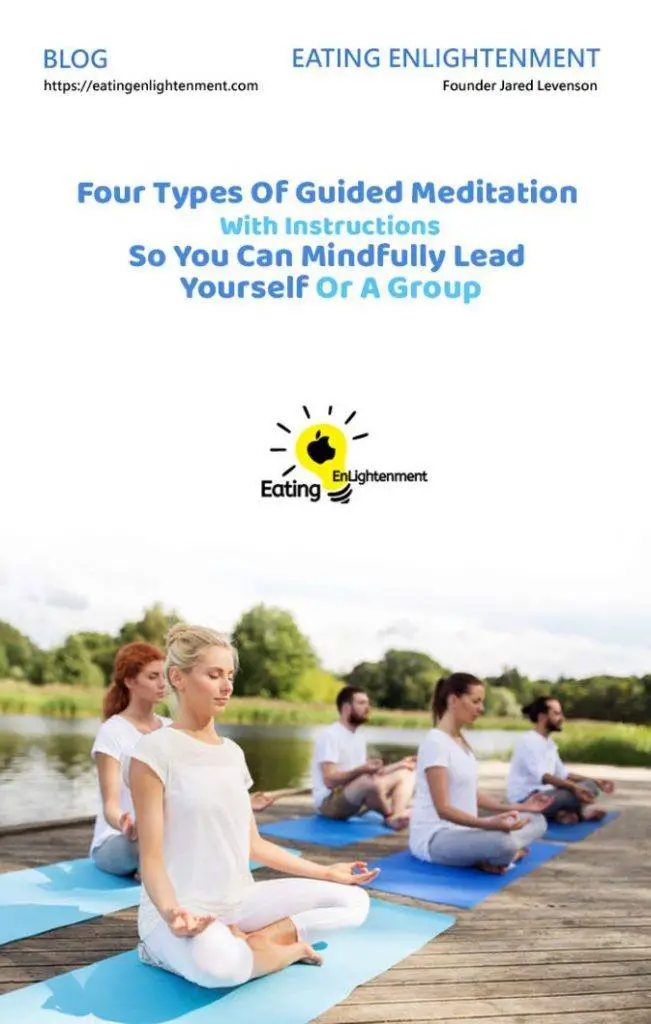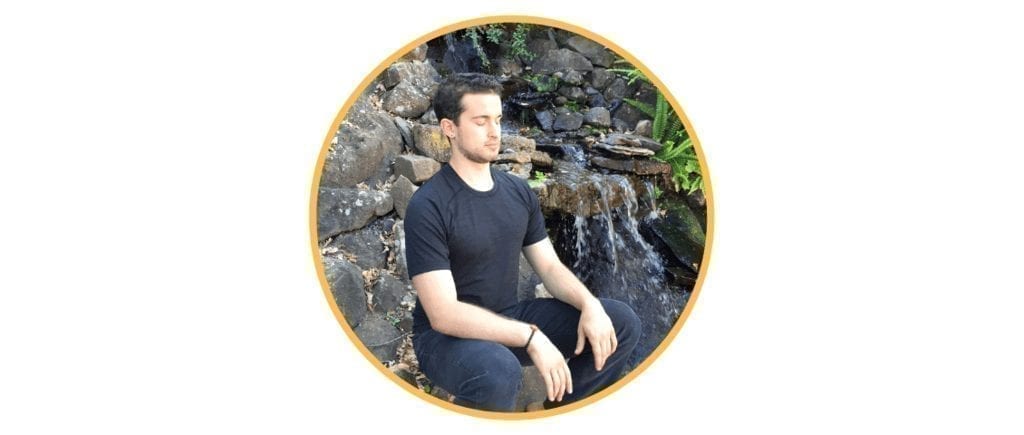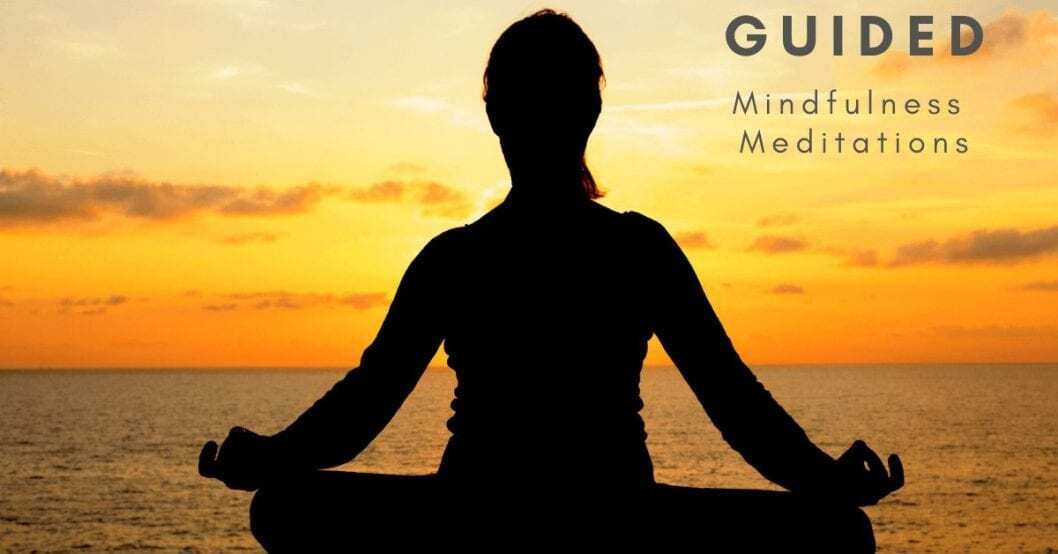Are you looking to lead yourself through a mindfulness guided meditation?

Or maybe you are in a leadership position – like a yoga instructor or meditation teacher – and need to guide a group of people?
In this post I share from both perspectives – mindfulness practitioner and yoga teacher. With over 10 years of experience practicing mindfulness (and 7 years teaching yoga), I can relate to the frustration of trying to calm my own mind, and I can also relate to the frustration of trying to help others calm their minds as well!
This post is written with the assumption you have a working understanding of mindfulness. Mindfulness is essentially a practice of bringing your mind back to the present moment in a nonjudgmental way, which is one of the best strategies to manage food cravings. Mindfulness has many benefits ranging from stress relief to helping people stop binge eating.
If you are familiar with mindfulness, here are the topics we’ll cover today:
- What Is Guided Meditation – External versus Internal
- Three Guided Meditation Mindfulness Techniques
- Breathing Guided Meditation
- Body Scanning Guided Meditation
- Walking Guided Meditation
- Peace Through Urges
- How To Guide Meditation – Your “Voice” Is A Key
In the second section where I provide 3 sets of guided meditation videos and instructions, please note the videos are intended for the individual who is trying to guide themselves through a meditation practice. Another way to utilize these scripts is for the teacher to read through them scripts before their class to familiarize themselves with potential ways to say different steps.
The sets of instructions that come beneath each video are intended for the yoga or meditation teacher. These instructions can also be used as scripts to be read during a yoga or meditation class at the appropriate moment. By the end, you’ll have a clear understanding of how to teach your own mindful guided meditation – whether just for yourself or for others.
It’s important to know that I am specifically covering guided meditation techniques for mindfulness, instead of other techniques that focus on visualizations or loving kindness. Mindfulness has been the type of meditation strategy I have used for 10+ years and is the basis for many advanced techniques found in Zen and Vipassana.
I give you permission to copy and use these meditations for your own personal use! Let’s dive in so you can clear your mind, reduce stress and begin accruing the benefits of mindfulness!

What Is Guided Meditation – External Versus Internal
Wikipedia gives you a very common definition of “guided meditation”, but I have a different interpretation. Let’s first see what Wikipedia has to say:
“Guided meditation is a process by which one or more participants meditate in response to the guidance provided by a trained practitioner or teacher, either in person or via a written text, sound recording, video, or audiovisual media comprising music or verbal instruction, or a combination of both.”
This is what I refer to as ‘external’ guided meditation. This form of meditation is probably what first comes to mind when you think about guided meditation:
A guru with a calm voice; a yoga teacher instructing you to follow your breath; an audio CD with humming music in the background. Someone else guiding you. You are the follower. They are the guide.
But there is another definition of guided meditation.
There’s nothing wrong at all with this “external” approach. But it’s not the only way. The alternative type of guided meditation is done by you! You lead yourself. I call this type of guided meditation the “internal” approach.
This internal guided meditation can provide you with the same benefits as the external approach.
- Stress relief
- Concentration
- Freedom from obsessive thoughts
But you really can ‘guide’ yourself. You can reach a state of inner peace while speaking to yourself, whether out loud or quietly to yourself. This is a great way to meditate!
Self-guided meditation is useful because then you are not dependent on an external source. External sources are great, but there will be a time when you don’t have your audio CD or guru nearby. What then?
So just realize you don’t necessarily need a CD or guide to practice ‘guided meditation’. Even so, whether it’s external or self-guided meditation, don’t underestimate! Both are incredibly useful. Even today after a decade of self-guided mindfulness meditation, I still will use externally guided meditations on a rough day.
Three Guided Meditation Mindfulness Techniques
Now that we have covered external and internal forms of meditation, let’s explore some common techniques to help you. The point of the previous section was to erase any doubt in your mind about the usefulness of guided meditation, whether to yourself or aloud.
For example, in any of the sections below, feel free to speak aloud or quietly to yourself. Each of these sections contains:
- Self-guided meditation video
- Scripted set of instructions.
Videos – The videos are meant for people who want a realistic idea of how to guide themselves in meditation. In these videos I record my own process of meditation while verbalizing my experiences aloud for you to hear.
Keep in mind that these are not rigid rules. Sometimes when following instructions you can think they provide a very precise, rigid way to meditate. But this perfectionistic attitude is actually more likely to lead to failure. There is a lot of mind wandering so expecting yourself to be perfect will only set you up for failure!
So I give instructions, but when we practice ourselves we need to expect a more flexible, humanistic approach.
Instructions – The instructions are meant for teachers who need to guide meditation in a public setting. You can read these instructions (or with your own modifications) or practice beforehand.
As an individual, you can also benefit by reading the instructions to get an overall sense of how to practice the specific technique. Just keep in mind that life is not a set of instructions and that when you practice yourself to take an easygoing, forgiving and flexible approach.
Breathing Guided Meditation
- Get in a comfortable position. If you are sitting down, have both feet flat on the floor.
- Find your breath and begin by inhaling and exhaling slowly.
- Try to inhale in and out through your nostrils. Let’s all take a few breaths together.
- For every inhale, gently count to 6 silently to yourself. As you exhale, silently count to 6.
- Pay attention to each inhale and each exhale. Notice how your breath feels.
- Explore:
- How deep do you breathe into your body?
- Where do you feel your breath the most? Perhaps you feel the breath most in your nostrils, or perhaps your lungs?
- Try to feel the temperature of your breath
- After a few breath cycles of breathing through your nose. Keep your attention on the breath. At this point, if you would like to try experimenting by breathing out through your mouth, instead of your nose, you are welcome to. Just notice how your experience change. Lastly, when your mind wanders, gently bring your attention back to your breathing. This is a great strategy to help manage food cravings.
Body Scanning Guided Meditation
This exercise can be done when you are meditating in place. Body scanning is where you place your attention in a place on your body and explore that feeling in your body.
Part 1: This first part of body scanning is just about simple relaxation. Let’s take a few moments to relax your body and get more settled.
- Begin by laying down on the ground or seated on a comfortable chair. If you need to scratch or itch you can, but try to stay still.
- Bring your awareness to your breath. Do not try to change the way you are breathing. Do this for a couple of minutes.
- Notice the outline of your body – the clothing on your skin, the pressure of the ground or chair on your back and legs.
- Notice any tension in your shoulders, mouth, forehead, jaw, throat or other areas that are tight.
Part 2: Here are a few quick instructions on the big picture idea of how to do a body scan meditation. After these principles, we will go step by step scanning the major regions of your body.
As I said above, body scanning is where you place your attention in a place on your body and explore that feeling in your body. You keep the attention in this region of your body for about 10-30 seconds. Then you shift your attention to the next part of your body.
The idea of this meditation is to practice letting go and be non-judgmental. As you scan, you will feel certain areas of your body very clearly. For other parts of your body, you will have a harder time feeling.
The point is to notice whatever it is you feel (or the lack of feeling) and to move on.
You might start your awareness in your feet, and maybe you feel this very clearly. You feel your feet for a few breaths or about 30 seconds. Whether you feel clearly or not, it’s OK.
Then shift your attention from your feet up to your calves. Maybe now you might really struggle to feel your calves. Your default reaction might be to think you are ‘succeeding’ or doing well when you scan your feet, and ‘failing’ when you scan your calves.
But in body scanning guided meditation, we are simply practicing noticing (including the inability to notice) and then moving on without any judgment.
So for your calves (if you can’t feel those muscles), just make a mental note that you can’t really feel much, keep your awareness in your calves for a little bit longer, and then scan farther up to your thighs.
So that’s the basic idea. Let’s all begin with your awareness at your toes and feet.
- Toes – with your awareness in your toes, notice:
- Do your feet itch?
- Do your toes tingle?
- Are there any sensations you can notice from your socks?
- Are your feet sweaty?
- Spend a few more breaths here just feeling your feet.
- Remember, no sensation is ‘good’ or ‘bad’. And if you can’t feel your feet, or if you can only barely feel your feet, that’s okay too.
- (wait a few moments) And when your mind wanders, you just gently bring your attention back to your feet.
- Calves – Begin scanning your awareness up from your toes into your calves.
- Notice if you can feel the front part of your calves.
- See if you can feel where your calves attach to your ankles and your knees
- Just take a few moments to explore your calves
- Now continue with similar verbiage and timing for the rest of your body:
- Knees
- Quads
- Hips
- Belly
- Low Back
- Upper chest
- Upper back
- Hands
- Forearms
- Neck
- Shoulders
- Head
Walking Guided Meditation
This exercise is usually done by yourself, or in meditation retreat settings. While it’s less likely that you will find yourself guiding a walking meditation, I still wanted to include this section for individuals because there actually are some simple opportunities to practice walking meditation! Some of these inconspicuous opportunities to practice walking meditation include:
- To and from your car
- Around your neighborhood
- Walking the dog
Here is how you practice walking meditation:
- Find a path to walk without distraction, like a stroll in the park or through your neighborhood.
- Feel free to wear shoes or go barefoot.
- Gaze down so cars passing or other people won’t distract you. Feel free to look up to cross the street or if something catches your eye, but try to bring your eyes back down.
- As you begin to stroll, bring all of your awareness to your feet:
- Notice your feet and legs
- As your feet plant onto the ground, just notice how the ground feels
- Note the feeling which occurs as you lift your foot
- Just be aware of any sensations in your foot, including your socks, shoes, pressure and itching
- Walk for a while, then turn back and walk around again.
- As you walk, periodically check in and ask yourself, “What am I thinking right now?”
- After you notice what you were thinking, just gently bring your mind back to your foot.
- You can experiment with different pacing, slow or fast, as you walk
- Of course feel free to just stand still and listen to the birds at any point
When I lived as a monk in Thailand, this was the method with which we would practice walking meditation. We’d have these long stretches of cleared paths through the forest. Green leaves would brush up against you as you walked. Then we’d stop and listen.
How To Guide Meditation – Your “Voice” is The Key
This section is for written for anyone who wants to conduct a guided meditation (or “external” meditation based on the first section):
- yoga teachers
- meditation instructors
- the person who wants to conduct their own self-guided meditation
Here I want to share with you a few insights that I have learned from 7 years of teaching yoga. From vinyasa to yin to gentle yoga to power yoga, from individual to corporate classes – I have experience teaching in all sorts of circumstances. Most importantly, I’ve been blessed to have gotten much constructive feedback from other teachers, yoga studio owners, and certification training!
The key that I want to share is that the best way to learn how to guide meditation is to attend an actual guided meditation or a yin yoga class and pay specific attention to the teacher’s voice.
One time I brought my family to a casual mindfulness retreat at Insight Meditation Center in South Bay, led by Gil Fronsdale. This was a very meaningful experience for me! I really put forth a sincere effort that day to practice mindfulness, and after a few hours I was able to really release some tension I had been carrying!
Throughout this whole process, I couldn’t help but notice Gil’s calming, soothing, and plain voice. It was quiet, but not too quiet. It was pleasant and pretty normal.
Be careful where you seek this!
If you try out a vinyasa class at a yoga studio that focuses mostly on making you sweat, you will be treated to loud music and a great workout! While there’s nothing wrong with loud music and a great workout, you probably won’t hear the best examples of the voice you need for guided meditation. Not all yoga classes are created equal in terms of learning to guide meditation, so choose wisely.
If you are sincerely interested in learning to guide meditation in a skillful manner, I highly suggest you ask around and take a class with an expert, one who people recommend at least in part because of their voice. I want to touch on this point again because this really is the key to learning how to do guided meditations in a group setting.
Here’s a true story about voice. There was a really popular woman who taught a really simple yoga class. Before I took her class, I always wondered why she was so popular. I had heard that her classes weren’t anything special from a physical standpoint. So what made people flock to her like moths to a flame?
I took her class and immediately understood why. Among other great qualities, this woman had an incredibly safe and calming tone.
- She spoke quietly and softly, but firmly. But she also wasn’t too quiet. You could hear her.
- Her voice was calm, rhythmic, resonant and had practiced developing her voice while teaching yoga for many years I’m sure.
- She used an even pacing without speeding up or slowing down
I could go on about the ideal tone and how to find your perfect pitch, but the best way to learn how to guide a meditation is to simply listen to other people guiding a meditation or a yoga class.
With all of this being said … go try a mindfulness guided meditation. Which one is your favorite guided meditation?



